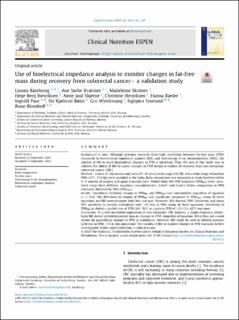| dc.contributor.author | Bärebring, Linnea | |
| dc.contributor.author | Kværner, Ane Sørlie | |
| dc.contributor.author | Skotnes, Madeleine | |
| dc.contributor.author | Henriksen, Hege | |
| dc.contributor.author | Skjetne, Anne Juul | |
| dc.contributor.author | Henriksen, Christine | |
| dc.contributor.author | Ræder, Hanna | |
| dc.contributor.author | Paur, Ingvild | |
| dc.contributor.author | Bøhn, Siv Kjølsrud | |
| dc.contributor.author | Wiedswang, Gro | |
| dc.contributor.author | Smeland, Sigbjørn | |
| dc.contributor.author | Blomhoff, Rune | |
| dc.date.accessioned | 2020-11-13T08:48:19Z | |
| dc.date.available | 2020-11-13T08:48:19Z | |
| dc.date.created | 2020-10-26T20:02:31Z | |
| dc.date.issued | 2020 | |
| dc.identifier.citation | Clinical Nutrition ESPEN. 2020, 40, 1-7. | en_US |
| dc.identifier.issn | 2405-4577 | |
| dc.identifier.uri | https://hdl.handle.net/11250/2687704 | |
| dc.description.abstract | Background & aims
Although previous research show high correlation between fat-free mass (FFM) measured by bioelectrical impedance analysis (BIA) and dual-energy X-ray absorptiometry (DXA), the validity of BIA to track longitudinal changes in FFM is uncertain. Thus, the aim of this study was to validate the ability of BIA to assess changes in FFM during 6 months of recovery from non-metastatic colorectal cancer (CRC).
Methods
A total of 136 women and men (50–80 years) with stage I-III CRC and a wide range of baseline FFM (35.7–73.5 kg) were included in the study. Body composition was measured at study baseline within 2–9 months of surgery and again 6 months later. Whole-body BIA FFM estimates (FFMBIA) were calculated using three different equations (manufacturer's, Schols' and Gray's) before comparison to FFM estimates obtained by DXA (FFMDXA).
Results
Correlation between changes in FFMBIA and FFMDXA was intermediate regardless of equation (r ≈ 0.6). The difference in change of FFMBIA was significant compared to FFMDXA, using all three equations and BIA overestimated both loss and gain. However, BIA showed 100% sensitivity and about 90% specificity to identify individuals with ≥5% loss in FFM, using all three equations. Sensitivity of FFMBIA to detect a smaller loss of FFM (60–76%) or a gain in FFM of ≥5% (33–62%) was poor.
Conclusion
In a well-nourished population of non-metastatic CRC patients, a single-frequency whole-body BIA device yielded imprecise data on changes in FFM, regardless of equation. BIA is thus not a valid option for quantifying changes in FFM in individuals. However, BIA could be used to identify patients with loss in FFM ≥5% in this population. The validity of BIA to monitor changes in FFM warrants further investigation before implementation in clinical praxis. | en_US |
| dc.language.iso | eng | en_US |
| dc.rights | Attribution-NonCommercial-NoDerivatives 4.0 Internasjonal | * |
| dc.rights.uri | http://creativecommons.org/licenses/by-nc-nd/4.0/deed.no | * |
| dc.title | Use of bioelectrical impedance analysis to monitor changes in fat-free mass during recovery from colorectal cancer– a validation study | en_US |
| dc.type | Peer reviewed | en_US |
| dc.type | Journal article | en_US |
| dc.description.version | publishedVersion | en_US |
| dc.source.pagenumber | 1-7 | en_US |
| dc.source.volume | 40 | en_US |
| dc.source.journal | Clinical Nutrition ESPEN | en_US |
| dc.identifier.doi | 10.1016/j.clnesp.2020.09.021 | |
| dc.identifier.cristin | 1842445 | |
| cristin.ispublished | true | |
| cristin.fulltext | original | |
| cristin.qualitycode | 1 | |

